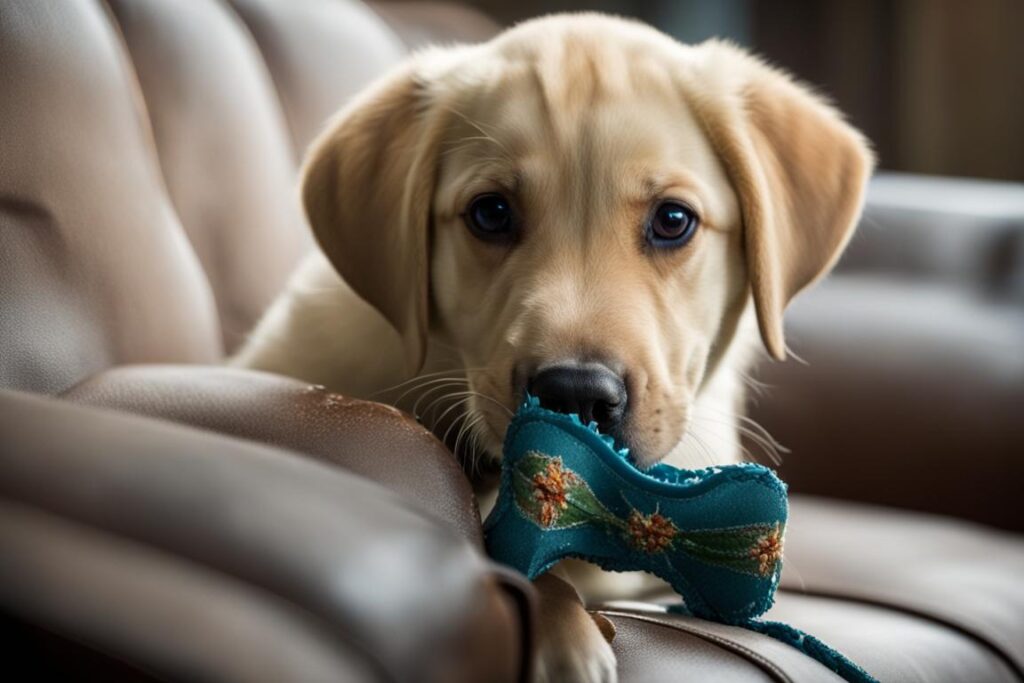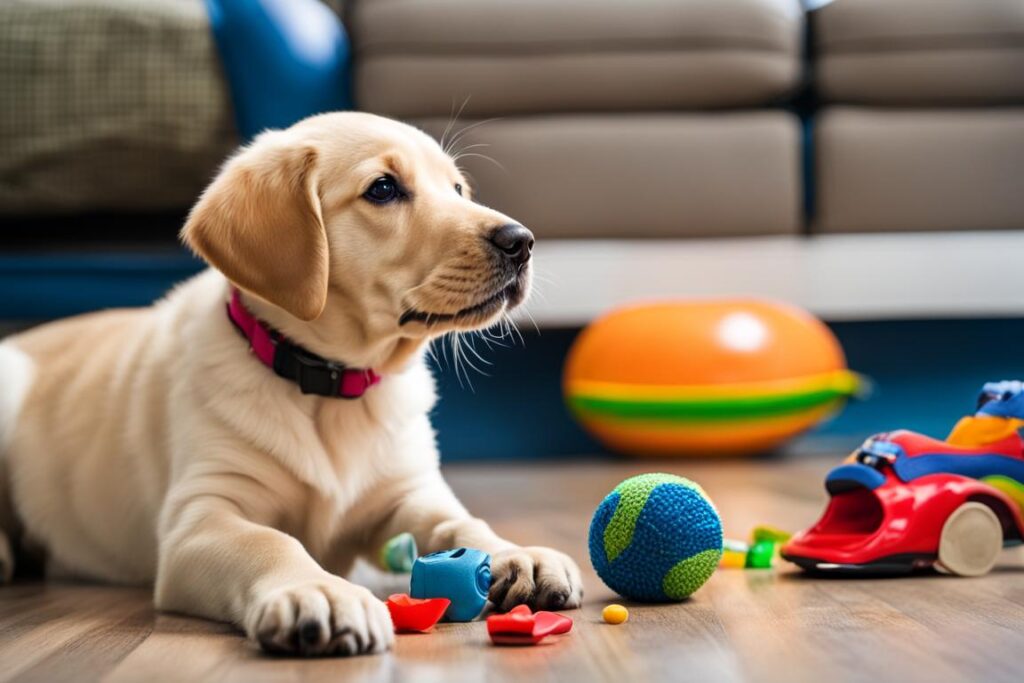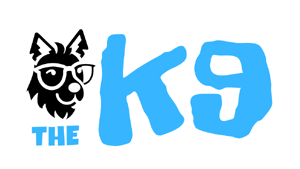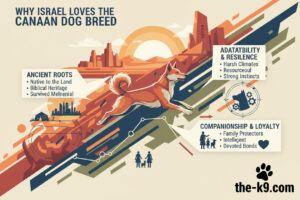
How to Stop Play Biting, Mouthing & Chewing in Labradors. Do you have a Labrador who just can’t seem to stop play biting, mouthing, and chewing? It’s a common challenge faced by many pet parents. But what if I told you there was a way to put an end to these behaviors and enjoy more peaceful interactions with your furry friend?
Labradors are known for their energetic nature and love for playtime. However, their playfulness can sometimes escalate into unwanted behaviors, like biting, mouthing, and excessive chewing. This not only causes discomfort but can also lead to damage around your home.
So, how can you effectively address these behaviour’s and train your Labrador to be well-behaved? In this article, we will explore proven techniques and strategies to put an end to play biting, mouthing, and chewing in Labradors. From understanding the underlying causes to implementing behavioural and obedience training, we will guide you every step of the way.
Key Takeaways: How to Stop Play Biting, Mouthing & Chewing in Labradors
- Play biting, mouthing, and chewing are common behaviors in Labradors that can be addressed through proper training techniques.
- Distinguishing between playful mouthing and aggressive behavior is crucial for effective intervention.
- Teaching bite inhibition and impulse control are essential in curbing unwanted biting and mouthing in Labradors.
- Providing appropriate toys and chews can help redirect your Labrador’s chewing behavior.
- Consistency, positive reinforcement, and mental stimulation are key factors in stopping play biting, mouthing, and chewing in Labradors.
- Is It Playful Mouthing or Aggressive Behavior?
- How to Minimize Your Dog’s Mouthing and Nipping
- What to Do Next: Teach Your Dog That Teeth Don’t Belong on Human Skin
- Why do Dogs Chew?
- How to Stop a Dog from Chewing
- Seven Steps: How to Stop Play Biting, Mouthing & Chewing in Labradors
- Puppy-Proof Your Living Space
- Provide Suitable Toys and Chews
- Always Keep a Toy Handy
- Conclusion: How to Stop Play Biting, Mouthing & Chewing in Labradors
Is It Playful Mouthing or Aggressive Behavior?
Understanding whether your Labrador’s biting behavior is playful mouthing or aggressive can be challenging. Playful dogs typically have a relaxed body and face, while those displaying aggression may exhibit tension in their facial muscles. Aggressive bites are generally faster and more painful than playful bites.
If you suspect that your Labrador’s biting is aggressive, it is crucial to seek guidance from a qualified professional. Certified Applied Animal Behaviorists or board-certified veterinary behaviorists can provide expert advice and assistance in addressing and managing aggressive biting tendencies.
It is essential to distinguish between playful mouthing and aggressive behavior to ensure the safety and well-being of both your dog and those around them. Proper assessment and intervention from professionals will help create a harmonious environment for you and your Labrador.
How to Minimize Your Dog’s Mouthing and Nipping
Dogs love to play, explore, and chew on objects. However, it’s essential to teach your dog to be gentle and understand that people have sensitive skin. By practicing bite inhibition and providing appropriate training and toys, you can help minimize mouthing and nipping behaviors in Labradors.
Bite inhibition is the ability for dogs to control the force of their mouthing. It can be taught using effective training techniques. One method is to yelp or say “ouch” in a high-pitched voice when your dog bites too hard. This mimics the way puppies learn from their littermates. You can also use a time-out procedure by immediately stopping play whenever your dog mouths or nips you, giving them a brief break before resuming the activity.
Another important aspect is teaching your dog impulse control. This can be achieved through obedience training and reinforcing positive behaviors. By teaching your dog commands like “leave it” or “drop it,” you can redirect their attention to appropriate activities and discourage mouthing or nipping.
Providing plenty of appropriate toys and chews is crucial to minimize mouthing and nipping. Look for toys specifically designed for chewing, such as durable rubber toys or dental chews. These toys not only satisfy your dog’s natural urge to chew but also provide mental stimulation.
What to Do Next: Teach Your Dog That Teeth Don’t Belong on Human Skin
Once your dog has learned to be gentle with his mouth, the next step is to teach him to avoid mouthing people altogether. It’s important to train your dog that chewing on human skin is not acceptable behavior. Here are some strategies to help you teach your dog to stop chewing on human skin:
- Substitute with toys or chew bones: Whenever your dog tries to gnaw on your fingers or toes, immediately substitute the inappropriate object with a toy or chew bone that he is allowed to chew on. This will redirect his attention and reinforce the idea that human skin is not for chewing.
- Distract with small treats: If your dog gets overly excited during petting and starts mouthing, distract him by offering small treats. This will help him associate gentle behavior with rewards and discourage him from mouthing on human skin.
- Encourage noncontact forms of play: Engage your dog in noncontact play activities, such as fetch or tug-of-war. This will redirect his energy and focus away from mouthing people and onto appropriate toys or objects.
- Teach impulse control: Train your dog to have better impulse control by practicing obedience commands like “sit,” “stay,” and “leave it.” This will help him learn to resist the urge to chew on human skin and instead follow your commands.
- Provide interesting and new toys: Make sure your dog has a variety of interesting and new toys to chew on. This will keep him engaged and satisfied, reducing the likelihood of him resorting to chewing on human skin out of boredom.
By consistently implementing these techniques, you can effectively teach your dog that chewing on human skin is not appropriate behavior. Remember to remain patient and reinforce positive behaviors with rewards and praise.
Teaching your dog not to chew on human skin is crucial for maintaining a healthy and respectful relationship between you and your furry companion. With consistent training and guidance, your dog can learn to redirect his chewing behavior onto appropriate toys and objects.
Why do Dogs Chew?
Dogs and puppies have a natural instinct to chew on things. They use chewing as a way to explore the world around them, play, relieve stress, and ease teething discomfort. For Labrador Retrievers, this chewing behavior is particularly strong due to their retriever genes. It’s important for dog owners to understand why their dogs chew and provide appropriate outlets for this behavior.
Chewing helps dogs exercise their jaws and clean their teeth. It also provides mental stimulation, especially for intelligent breeds like Labradors. Without appropriate toys and chews, dogs may resort to chewing on furniture, shoes, or other items around the house, which can be destructive and costly.
To prevent unwanted chewing behavior, it is crucial to provide your dog with suitable toys and chews. These should be made of durable materials and designed to withstand strong chewing. Avoid giving your dog items that resemble objects they are not supposed to chew, such as old socks or stuffed animals. Instead, choose toys specifically designed for dogs.
When selecting toys and chews, consider your dog’s size, age, and chewing habits. For puppies, choose softer toys suitable for their tender gums during teething. As they grow, you can gradually introduce harder toys to satisfy their chewing needs. Interactive toys, such as puzzle toys or treat-dispensing toys, can also keep your dog mentally engaged.
Remember that supervision is essential when giving your dog toys and chews. Regularly inspect them for signs of wear and tear, and replace them if they become damaged or pose a choking risk. Keeping your dog’s toys clean and rotating them regularly can also help maintain their interest and prevent boredom.
How to Stop a Dog from Chewing
To stop a dog from chewing, it’s important to understand why they are chewing in the first place. Some common reasons include boredom, anxiety, teething, and habit. Providing appropriate toys, managing their environment, and ensuring they get enough mental and physical stimulation can help prevent destructive chewing behavior.
Identifying the Root Cause of Chewing
Before addressing the chewing behavior, it’s crucial to determine the underlying cause. Dogs may chew out of boredom or lack of stimulation, seeking attention, relieving anxiety or stress, or simply due to their natural teething process. By identifying the reason behind their chewing, you can implement targeted strategies to address the issue effectively.
Providing Appropriate Toys
One of the most effective ways to redirect a dog’s chewing behavior is by providing them with appropriate toys. Chew toys made of durable materials such as rubber or nylon can satisfy their need to chew while preventing damage to your belongings. Look for toys specifically designed to withstand heavy chewing and consider rotating them to maintain your dog’s interest.
Tip: Consider offering puzzle toys or treat-dispensing toys to mentally stimulate your dog, keeping them engaged and less likely to engage in destructive chewing.
Managing the Environment
Creating a dog-proof environment is essential for preventing unwanted chewing incidents. Keep valuable items and potential hazards out of your dog’s reach. Use baby gates or crate training to restrict access to certain areas of your home when you’re unable to supervise them. Additionally, providing a designated chewing zone with their toys can help redirect their chewing behavior to appropriate objects.
Ensuring Mental and Physical Stimulation
Adequate mental and physical stimulation is crucial for preventing destructive chewing in dogs. Regular exercise, interactive play sessions, and training activities can help burn off excess energy and keep them mentally engaged. Consider activities such as obedience training, agility exercises, or puzzle games that challenge their problem-solving skills.
Tip: Labradors, in particular, benefit from regular exercise due to their high energy levels. Aim for daily walks, play sessions, and activities that cater to their natural instincts.
Implementing these strategies and providing your dog with appropriate outlets for their chewing needs can help curb destructive chewing behaviors. Remember to be patient, consistent, and offer positive reinforcement as your dog learns and adjusts their behavior.
Seven Steps: How to Stop Play Biting, Mouthing & Chewing in Labradors
Dogs chewing and mouthing can be frustrating, but with proper training and consistent techniques, you can address these behaviors effectively. Here are seven essential steps to help stop your dog from chewing and mouthing:
1. Puppy-proof your living space
Puppy-proofing your home is crucial to prevent your dog from accessing items they shouldn’t chew on. Keep valuables, shoes, cords, and small objects out of reach. Use child gates or a playpen to restrict access to certain areas.
2. Provide suitable toys and chews
Give your dog a variety of toys and chews made specifically for chewing. This will redirect their chewing behavior to appropriate items. Consider different textures and materials to keep them engaged.
3. Keep a toy handy
Always have a toy or chew nearby to redirect your dog’s attention when they start chewing or mouthing. Offer the toy as a substitute for your hands or furniture. This will help them understand appropriate chewing behavior.
4. Avoid rough and tumble wrestling games
Discourage games that involve rough play or wrestling, as this can encourage biting and mouthing. Instead, focus on interactive games that strengthen the bond between you and your dog, such as fetch or hide-and-seek.
5. Stop play if they start biting
If your dog starts biting during play, immediately stop the activity and withdraw your attention. This teaches them that biting leads to the end of playtime. Resume play only when they have calmed down.
6. Do not punish for mouthing or chewing
Avoid punishing your dog for chewing or mouthing. Punishment can create fear or anxiety, which may worsen the behavior. Instead, provide positive reinforcement when they chew appropriate toys and redirect them when they chew on undesired objects.
7. Provide exercise and mental stimulation
Dogs often chew out of boredom or excess energy. Ensure your dog gets enough physical exercise through walks, playtime, and interactive activities. Mental stimulation, such as puzzle toys or training sessions, can also help redirect their energy.
By following these seven steps, you can effectively train your dog to stop chewing and mouthing. Consistency, patience, and positive reinforcement are key. Remember to provide appropriate toys, redirect their attention, and address any underlying causes for chewing behavior.
| Step | Description |
|---|---|
| 1 | Puppy-proof your living space by removing chewable items and restricting access. |
| 2 | Provide a variety of suitable toys and chews to redirect chewing behavior. |
| 3 | Keep a toy handy to redirect your dog’s attention when they start mouthing or chewing. |
| 4 | Avoid rough play and focus on interactive games that don’t encourage biting. |
| 5 | Stop play immediately if your dog starts biting and resume only when they have calmed down. |
| 6 | Avoid punishment for mouthing or chewing and provide positive reinforcement instead. |
| 7 | Ensure your dog gets enough exercise and mental stimulation to prevent boredom chewing. |

Following these steps will help you establish good chewing habits for your dog and maintain a harmonious living environment.
Puppy-Proof Your Living Space
When bringing a new puppy into your home, it’s essential to puppy-proof your living space to prevent unwanted chewing behavior. By taking a few simple steps, you can create a safe and conducive environment for your Labrador puppy.
Removing Prized Possessions or Putting them Out of Reach
Labradors are curious and energetic puppies who love to explore their surroundings. To protect your valuable items from being chewed on, remove them from your puppy’s reach or store them safely in closed cabinets and drawers.
Using Child Gates or a Playpen to Restrict Your Puppy’s Access
Setting up child gates or using a playpen can help limit your puppy’s access to certain areas of your home. This ensures they stay in safe and supervised areas where they can play and explore without the risk of damaging furniture or cords.
Providing a Safe and Fun Chewing Zone with Appropriate Toys
Labradors have a natural instinct to chew, especially during their teething phase. It’s important to provide them with appropriate toys that are safe and durable. Chew toys made of rubber or nylon can help satisfy their chewing needs and redirect their focus away from household items.
Remember, puppies rely on their mouths to explore the world. By offering them suitable alternatives, you can prevent unwanted chewing and keep your belongings intact.
Creating a puppy-proofed living space is a proactive approach to prevent chewing behaviors. By removing temptations, setting boundaries, and offering appropriate toys, you can set your Labrador puppy up for success in learning proper chewing habits.
Provide Suitable Toys and Chews
When it comes to keeping your Labrador entertained and engaged, offering a variety of toys made of different materials is key. Choose toys that are sturdy and designed specifically for chewing to ensure they hold up to your Labrador’s strong jaws. Rope toys, rubber toys, and soft toys are all excellent options that can help satisfy your dog’s natural chewing instincts.
One popular choice is the KONG Classic Dog Toy, which is made of durable rubber and can be filled with treats or peanut butter to provide a lasting and engaging chewing experience. Another great option is the Nylabone Dura Chew Textured Dog Chew, which is designed to withstand heavy chewing and help clean your dog’s teeth.
It’s important to regularly swap out your Labrador’s toys to keep them interested and avoid boredom. Introducing new toys and rotating them every few days can help maintain your dog’s interest and prevent them from becoming destructive with their chewing behavior.
| Toy | Description |
|---|---|
| The KONG Classic Dog Toy is a durable rubber toy that can be filled with treats or peanut butter. | |
| The Nylabone Dura Chew Textured Dog Chew is a long-lasting chew toy that helps clean your dog’s teeth. |
Always Keep a Toy Handy
When it comes to managing your Labrador’s chewing and play biting behaviors, one effective strategy is to always have a toy within reach. By recognizing the signs that your puppy is getting ready to play, such as an increase in energy or playful behaviors, you can redirect their attention and teach them appropriate behaviors.
Labradors have a natural instinct to chew, and providing them with a variety of suitable toys can help satisfy their chewing needs. When you notice your puppy starting to chew on inappropriate objects or mouthing at you, quickly offer them a toy as an alternative.
By redirecting their focus onto the toy, you can help prevent destructive chewing and play biting. This technique helps them understand what items are acceptable to chew on, reinforcing positive behavior and discouraging the unwanted ones.
Remember to choose toys that are safe and durable for your Labradors. Look for toys specifically designed to withstand heavy chewing and consider their size and age when making a selection. Regularly inspect the toys for any signs of wear and tear and replace them if necessary.
Benefits of Keeping a Toy Handy:
- Redirects their attention from inappropriate chewing and play biting
- Encourages appropriate chewing behavior
- Helps satisfy their natural instinct to chew
- Strengthens the bond between you and your Labrador through positive reinforcement
In addition to providing toys, it’s important to continue their training and socialization. Consistency and patience are key when redirecting their behaviors. With time, your Labrador will learn that toys are more fun to chew on, and their play biting and chewing habits will become more controlled.
Conclusion: How to Stop Play Biting, Mouthing & Chewing in Labradors
By implementing the right training techniques and maintaining consistency, you can effectively address and prevent play biting, mouthing, and chewing in Labradors. It is crucial to understand the underlying reasons behind their behavior and address them accordingly. Positive reinforcement plays a key role in modifying their behavior, while redirecting their attention to appropriate toys and chews helps them develop the right chewing habits.
Remember to provide your Labradors with a variety of suitable toys and mental stimulation to keep them engaged and satisfied. Puppy-proofing your living space and keeping a toy handy for redirection are important steps in creating a chewing-friendly environment. Additionally, offering regular exercise and mental stimulation will help prevent boredom and reduce their inclination to engage in destructive chewing behavior.
With patience, consistent training, and a focus on providing appropriate outlets for their chewing instincts, you can ensure that your Labradors develop healthy chewing habits and refrain from play biting and mouthing. By following these guidelines, you’ll have a happy and well-behaved companion for years to come.











